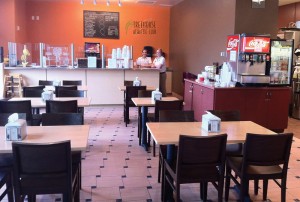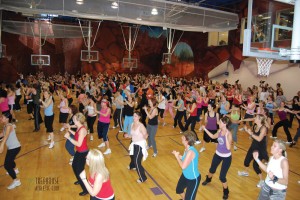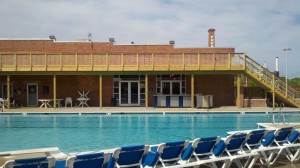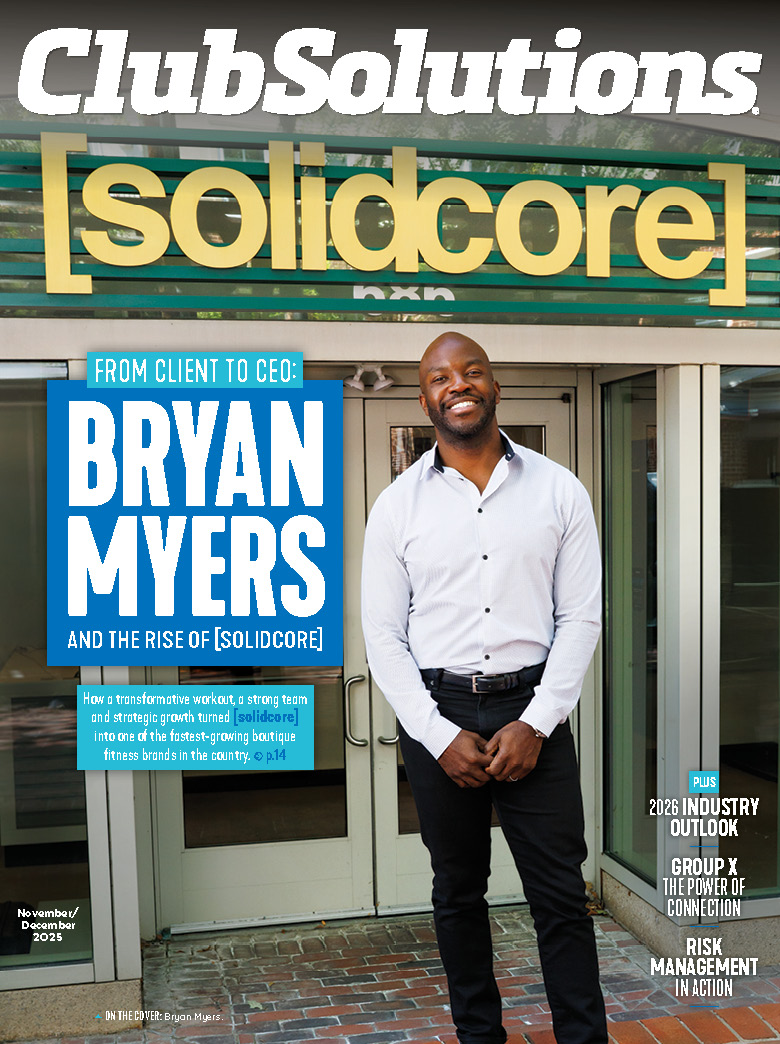 Once you get a member signed up and already paying for something, they are more likely to spend more money — and they should be spending it at your club’s profit centers.
Once you get a member signed up and already paying for something, they are more likely to spend more money — and they should be spending it at your club’s profit centers.
“The majority of our money comes from keeping the members we have, and keeping them in the club longer,” said Terry Dezzutti, the COO of Merritt Athletic Clubs.
What Clubs Offer
Merritt Athletic Clubs have developed several ways to make more money — including: tenants who rent space within the clubs, facility rentals for members, food and beverage options, including a restaurant, pool and juice bars; pro and retail shops, swim lessons, children’s summer camps and adult classes.
“You’re getting your nails done while your husband works out, and then later you both get to lay by the pool and have a drink,” said Dezzutti, painting a picture of what a day at Merritt could be like for members. “Now that’s a great day.”
The Alaska Club has figured out a way to encourage more spending on their profit centers — “Membership Plus,” a rewards program that can be added to any individual membership for a monthly fee. The program provides discounts for members to use on club amenities like free tanning, Zumba, DVD rentals, $35 massages and discounts at the pro shop and on childcare. They also offer members facility rentals, spa services, personal training, snack bars, tennis, swimming and tanning separately as well as a kid’s summer camp.
“We were looking for ways to generate more revenue and we looked outside of the industry to see what was successful,” said Gary Sossamon, the vice president of operations for The Alaska Club. “The most successful options were getting people to commit to a monthly fee. We wanted something that would be attractive to members.” Last year, Membership Plus, launched in 2008, brought in almost $600,000 in net profit.
Focusing on families broadens a profit center’s appeal. The Treehouse Athletic Club, in Utah, caters to families by offering kids programs, swim teams, sports, dance lessons, a day spa and a café. “There’s something for everyone at Treehouse,” said Annemarie Christopulos, the general manager at Treehouse Athletic Club. “We want everyone to find their niche.”
Treehouse operates its own spa and recently sold over 800 spa deals with Groupon.com, an online daily-deal website. The spa is open to non-members as well, with about 30 percent of patrons being non-members. Christopulos said it gives clubs more control of what they can offer and how they can market it to members.
 Marketing and Implementation
Marketing and Implementation
Members need to be told what’s going on inside the club. Expecting them to know what spa services are offered just because they walk past the spa to check-in isn’t a full-proof plan. Most members are focused on their workouts and getting in and out — it’s up to the club to guide members to other things to keep them in the club longer.
Treehouse relies on e-mail and social media, in conjunction with the club’s website and in-house marketing, to spread the word about member options. Treehouse also works with the local schools and community, Christopulos said. The Alaska Club utilizes the same tools. Positioning “Membership Plus” as a free option for the first few months of membership, allowing members to become hooked on the discounts and create a habit, Sossaman said.
Merritt has specific steps in place to add a new profit center to the mix. “We look for a champion, someone that has a lot of passion for what they will be doing and not necessarily the history in it,” Dezzutti said. The champion could be anyone — usually either a member or employee that will follow through with their idea.
“We become a 50/50 net partner with them [the champion],” Dezzutti said. “We fund the capital for a program, ask them to come up with the minimum number of attendees needed and come up with a flow sheet. We work with the partner to help them successfully implement the program.”
The Merritt Athletic Clubs select programs by demand; “demand is power” according to Dezzutti. The goal for every program is to make a net profit of 20-30 percent of its total revenue — that’s how Merritt measures a viable program. In the event that Merrit discovers a “champion,” they freeze the member’s account and hire them. “We do not have any independent contractors, if they don’t want to work for us they become vendors and pay us rent.” After the initial investment and program launch, it’s up to the director of the program to keep it running and make sure it’s something they want to keep investing time and energy into.
The energy created in a club is what usually makes a program successful Dezzutti said, “I like to call it ‘the new wow,’ something people get excited about and it creates energy in the club. It’s the hot thing, the hot activity.”
Brainstorming new ideas comes from both executive and staff levels at The Alaska Club. Employees can participate in the “Big Idea Program” that offers cash rewards to employees for their ideas. “We ask for revenue generating and cost-saving ideas,” Sossaman said. Employees must meet certain criteria to earn the cash reward, including sustained employment at the end of that calendar year, and the reward is only given once the idea is selected and implemented.
 Christopulos said her staff understands what she expects of an idea before they bring it to her. Treehouse chooses one foundation a year that they do fundraising for. Some new programs and partnerships happen easily — Treehouse is partnering with their local Noodles & Company to create a Bingo-like program for kids who will have to do certain activities. Other ideas are formed by looking logically at an idea, running numbers and developing statistics for revenue, money and time invested.
Christopulos said her staff understands what she expects of an idea before they bring it to her. Treehouse chooses one foundation a year that they do fundraising for. Some new programs and partnerships happen easily — Treehouse is partnering with their local Noodles & Company to create a Bingo-like program for kids who will have to do certain activities. Other ideas are formed by looking logically at an idea, running numbers and developing statistics for revenue, money and time invested.
“It takes about 30 days for us to get an idea of where [the program] is going,” Christopulos said. “People are excited about anything new at first, but we look to see if the excitement wears off.”
Coming up with creative profit centers gives members a reason to spend more money in your club. They can be good investments for the club used as a retention tool in many cases.
“You have to entertain [members],” Dezzutti said. “We want to be more of a lifestyle and a place to hang out.” -CS
Developing new profit center ideas is only half the battle. There’s also the implementation, additional training of staff and marketing to members. Most vendors try and make this as easy on the club as possible.
“Accurate accountability” can be created for your members with help from Polar Electro. “Polar technology not only allows clubs to track members’ attendance; it can also provide invaluable metrics such as heart-rate zone, calories burned, distance covered and more,” said Jesse Harper, the director of sales, education and health clubs at Polar Electro.
Polar offers many products that can be used in conjunction with clubs, and specifically personal training to help generate more revenue. They also offer Cardio GX, a new approach to group exercise where members’ heart-rate data is transmitted live and displayed on a large screen so the instructor can be aware of exertion levels.
VO2 Fitness Assessments can generate extra revenue for your club. Clubs report that clients are willing to pay an average of $100 for a VO2 test and an average of $40 for metabolic testing, said Julie Kofoed, the vice president of marketing for KORR.
KORR sells the VO2 testing product, CardioCoach™ and the metabolic testing product, MetaCheck™. They will train and educate staff as well as add your club to their website where customers who are interested in finding these tests can find your club directly.
Total Gym Global Corporation’s GRAVITY program is designed for small group, multi-client and individual personal training on a single piece of equipment, said Tom Companaro, the president and CEO of Total Gym Global Corp. Investing in this one piece of equipment can have a direct impact to a club’s bottom line once it’s paid for.
Their marketing department produces plenty of GRAVITY marketing materials for clubs to use to attract clients such as brochures, posters, fliers and workout DVDs to help keep programs fresh.
Stocking cafes and juice bars with FitPro Milk allows clubs to offer the only real milk protein shake that has earned the Real Dairy Seal, meaning the product meets government standards and is a genuine dairy product. It’s a unique ready-to-drink protein supplement that gives operators the chance to sell a high-protein, shelf-stable, high-performance dairy product. “As a previous gym owner, the two things I wanted with cooler sales is that it would resale time after time and have great margins,” said Brad Kloss, the owner and chief manager of Pro Claim Nutrition.
Kloss added that Pro Milk’s sales team will work with its customers to ensure that FitPro Milk becomes a brand that all the gym patrons ask for after their workouts. FitPro Milk will be hosting sampling events with customers, ensuring marketing materials are properly utilized and working personally with operators to not only get FitPro Milk into the marketplace but to learn how to help operators market FitPro Milk more effectively and get valuable feedback to the sales team.
By Ali Cicerchi



![From Client to CEO: Bryan Myers and the Rise of [solidcore]](https://d296qbqev3kq48.cloudfront.net/wp-content/uploads/2025/11/06151333/CS-NovDec25-CoverStory-3-350x250.jpg)




